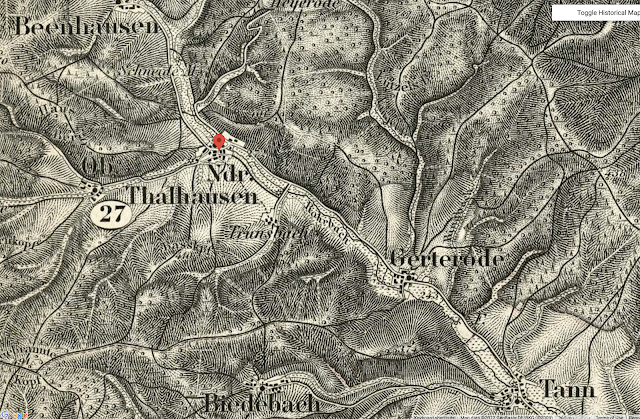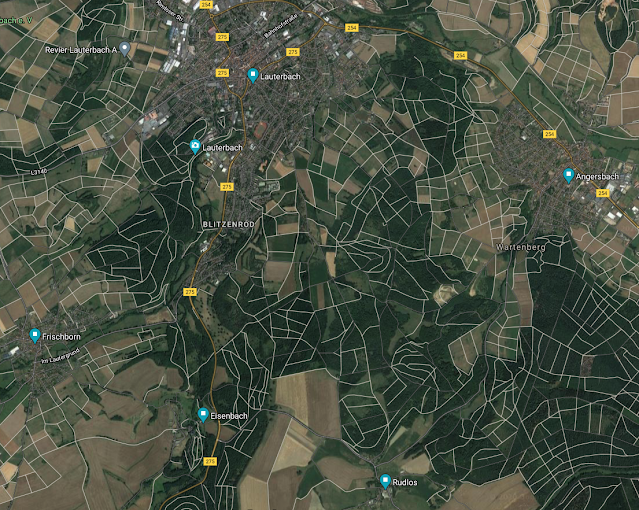For several months I have been searching for a link between the Rödigers of Tann and other communities having a significant Rödiger presence. I theorize that the Rödigers of Tann had "emigrated" to Tann from another ancestral home. My research shows that almost every Rödiger found in the Church Book of Tann have a common ancestor, Jost Rödiger (b. ca. 1657, d. 1710), who married Anna Margretha Schlein in 1679. 1664 is as far back as the Church Book of Tann can take us. There is a baptismal record in 1667 that names a Johannes Rödiger as Pfatter (baptismal sponsor).
I have found a reference to a Henn Rödiger in the book 650 Jahre Tann where he is listed as one of 12 farmers who had 1 horse and ox in 1627. So it appears that Rödigers lived in Tann at least as far back as that date. I have not discovered any other records that would help me connect Jost Rödiger with Henn Rödiger, but it seems almost certain that they were related. Henn could be Jost's grandfather or maybe a great uncle. But, it is certain that if Henn Rödiger had siblings or other children, none of their descendants except Jost continued the Rödiger name by the time of the beginning of the church records in Tann in 1664.
My Research Angel and silent contributor/editor of this Blog, Regina, has been providing me with links to church records of Rödigers that she comes across in her own research. This has led me to research the church records of Eisenach and Scherbda. I posted earlier on a Rödiger who emigrated to the US from Scherbda (Rödiger Curveball). Since that time I have researched this family and discovered that the immigrant's forebearers were not originally from Scherbda
MEANING OF THE NAME
According to the DFD* (netwww.namenforschung.net) the surname "Rödiger" is most likely derived from one of two sources. One is from the occupation of the earliest bearer of this surname and is based on Old High German hruod, Old Saxon *hrōth *rōth "Ruhm" and Old High German, Old Saxon gēr "Speer". "Ruhm" means "fame" or "glory" and "Speer" means "spear". This suggests that the originator of this surname was military and was a spear bearer of some renown.
The second possibility is that the original Rödiger was from a geographic location associated with this name. A rough translation of the text from the DFD says "Designation according to origin for the settlement name Rödigen, district of Lehesten in the Saale-Holzland district or district of Lödla in the district of Altenburger Land in Thuringia or district of Naumburg / Saale in the Burgenland district, Saxony-Anhalt. There is a derivative with the suffix -er."
While the romantic in me opts for the first possibility, the researcher in me inclines toward the second.
*Digitales Familiennamenwörterbuch Deutschlands (The Digital Dictionary of Surnames in Germany) "explores the current inventory of surnames in Germany and makes the findings easily accessible to users in digital form".
---------------------------------------
My Research Angel and silent contributor/editor of this Blog, Regina H., has been providing me with links to church records of Rödigers that she comes across in her own research. This has led me to research the church records of Eisenach and Scherbda. I posted earlier on a Rödiger who emigrated to the US from Scherbda (Rödiger Curveball). Scherbda is about 40 miles east of Tann.
Since that time I have researched this family and discovered that the immigrant's forebearers were most definitely not originally from Scherbda. The Scherbda church records begin in 1617, but the first mention of a Rödiger in Scherbda was in 1723. This was a baptismal record. The first Rödiger marriage was in 1729, and the first death record was in 1741. The man who died in 1741 was Hans Henrich Rödiger, age 78 years, 11 weeks and 1/2 days old. This would put his birth about 1663. There is no record of his marriage in Scherbda, the first marriage of a Rödiger in Scherbda records the name of the bride's father as Hans Henrich Rödiger, probably one and the same. He seems to have been the original Rödiger in Scherbda, arriving with this daughter, and a son, Hans George, who seems to have been the key to establishing the Rödiger name in Scherbda until the present day. Where did they come from??? Is there a DNA link between these two communities that might reveal a common ancestral home???
Y-DNA
This test can find ancestors of a man up the paternal side for many generations with very little room for error. This is because the Y chromosome is passed along from father to son almost like a carbon copy.
EXAMPLE
So, my 20th great grandfather Rödiger and I would be a match (assuming he had taken a DNA test, which of course he didn't). And every male Rödiger from his loins (a good biblical term) would also match. This means that all of his sons (not just my 19th great grandfather) and all of his sons' sons and all of his sons' sons' sons down 20 generations would be a Y-DNA match. Somewhere out there I have a 20th cousin that would be a match. So, let's just say that our 20th great grandfather lived in Village Alpha. He had two sons, one of which stayed in Alpha and had two more sons, one of whom left Alpha and married a woman from Village Beta, settled down and had two sons. One of the sons in Beta took a wife in Village Gamma and had two sons. So, now we have Rödigers in three different villages and every one of these male descendants' Y-DNA match with each other and with me.
So I took a Y-DNA test a couple of years ago and linked the results on FamilyTreeDNA.com with hopes that another Roediger or Rödiger from Alpha, Beta, Gamma somewhere in the world had also taken this test. But the unhappy result was that I had no matches. None. Very disappointing!
I thought perhaps there was a problem with my test, so I asked a third cousin (we share the same 2nd great grandfather Rödiger) if he would take this test. This he did and we had a match, so I knew the test was OK. So, one of two things has happened. Either no other Rödiger from a common ancestor has ever taken this test OR the test has been taken but is not in the FamilyDNA.com database. It may be in some other DNA database, but because these companies are not in the habit of sharing they will never show the match. But the truth of the matter is that FamilyDNA.com is one of the only companies to offer the Y-DNA test at this time.
For several months I have been searching for a link between the Rödigers of Tann and other communities having a significant Rödiger presence. I theorize that the Rödigers of Tann had "emigrated" to Tann from another ancestral home. My research shows that almost all the Rödigers found in the Church Book of Tann have a common ancestor, Jost Rödiger (b. ca. 1657, d. 1710) who married Anna Margretha Schlein in 1679. 1664 is as far back as the Church Book of Tann can take us. There is a baptismal record in 1667 that names a Johannes Rödiger as Pfatter (baptismal sponsor), and I have not been able to connect him with our family.
MEANING OF THE NAME
According to the DFD* (netwww.namenforschung.net) the surname "Rödiger" is most likely derived from one of two sources. One is from the occupation of the earliest bearer of this surname and is based on Old High German hruod, Old Saxon *hrōth *rōth "Ruhm" and Old High German, Old Saxon gēr "Speer". "Ruhm" means "fame" or "glory" and "Spear" means "spear". This suggests that the originator of this surname was military and was a spear bearer of some renown.
The second possibility is that the original Rödiger was from a geographic location associated with this name. A rough translation of the text from the DFD says "Designation according to origin for the settlement name Rödigen, district of Lehesten in the Saale-Holzland district or district of Lödla in the district of Altenburger Land in Thuringia or district of Naumburg / Saale in the Burgenland district, Saxony-Anhalt. There is a derivative with the suffix -er."
While the romantic in me opts for the first possibility, the researcher in me inclines toward the second.
*Digitales Familiennamenwörterbuch Deutschlands (The Digital Dictionary of Surnames in Germany) "explores the current inventory of surnames in Germany and makes the findings easily accessible to users in digital form".




























